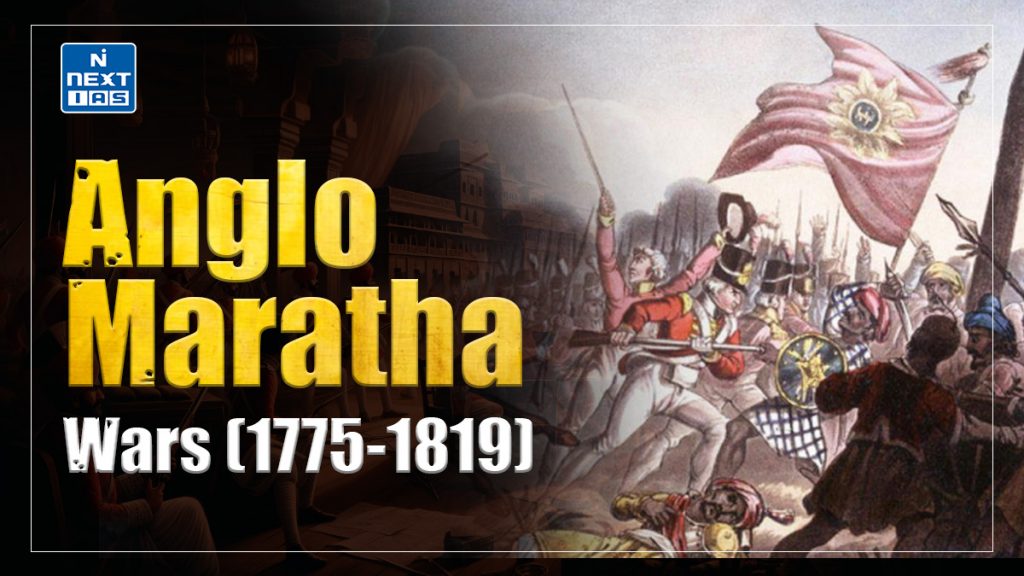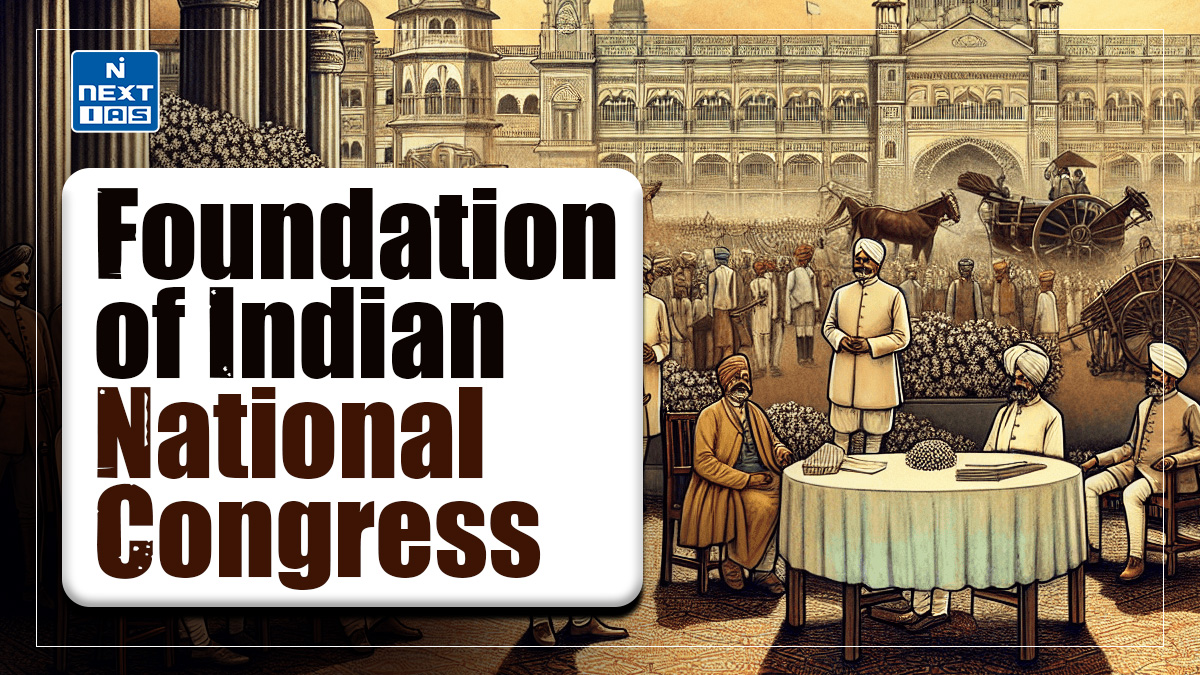
The Anglo-Maratha Wars (1775-1819) were a series of conflicts between the British East India Company and the Maratha Empire, ultimately leading to the decline of Maratha power in India. These wars marked a critical turning point in Indian history, facilitating British expansion and establishing dominance over the subcontinent. This article aims to study in detail the background, course, and outcomes of each war and their lasting impact on Indian politics and society.
About Anglo-Maratha War in India
- The Marathas had largely remained disunited since the Third Battle of Panipat (1761), in which Marathas were severely defeated.
- The third Peshwa Balaji Baji Rao could not withstand the shock of the defeat of the Marathas in the Third Battle of Panipat and died on June 23, 1761.
- The British best utilised the internal conflict among the Marathas in their expansionist policy.
- After Peshwa Balaji Baji Rao’s death, there were two factions within the Marathas: Peshwa Madhav Rao (supported by Nana Fadnavis) and former Peshwa Raghunath Rao (supported by the British).
First Anglo-Maratha War (1775-82)
Background of First Anglo-Maratha War
- In 1775, Madhav Rao and his uncle Raghunatha Rao disputed the post of Peshwa.
- The British authorities in Bombay concluded the Treaty of Surat with Raghunatha Rao in March 1775, according to which Raghunatha Rao promised to cede Bassein and Salsette to the British.
- Unwilling to fulfil his promise later, the British captured said territories. Warren Hastings, the Governor-General of Bengal, disapproved of the Bombay Government’s action.
- In 1776, Warren Hastings sent Colonel Upton to settle the issue. After that, the Treaty of Surat was cancelled, and the Treaty of Purandar concluded with Nana Fadnavis, another Maratha leader.
- According to this treaty, Madhav Rao II was accepted as the new Peshwa and the British retained Salsette and a heavy war indemnity.
- However, Warren Hastings disapproved of the Treaty of Purandar and sanctioned operations against the Marathas.
Course of First Anglo-Maratha War
- In the meantime, the British force sent by the Bombay Government was defeated by the Marathas.
- In 1781, Warren Hastings dispatched British troops under the command of Captain Popham.
- He defeated the Maratha chief, Mahadaji Scindia, in several small battles and captured Gwalior.
- Later, in May 1782, the Treaty of Salbai was signed between Warren Hastings and Mahadaji Scindia.
Outcomes of First Anglo-Maratha War
- As per the Treaty of Salbai (1782):
- Salsette and Bassein were given to the British.
- Raghunath Rao was pensioned off, and Madhav Rao II was accepted as the Peshwa.
- Accordingly, the Treaty of Salbai established British influence in Indian politics and gave the British twenty years of peace with the Marathas.
- The Treaty also enabled the British to exert pressure on Mysore, with the Marathas’ help recovering their territories from Haider Ali.
Second Anglo-Maratha War (1803-06)
Background of Second Anglo-Maratha War
- The Marathas were the only power that remained outside the purview of the subsidiary system.
- The Maratha Empire at that time consisted of a confederacy of five major chiefs: the Peshwa (Prime Minister) at the capital city of Poona, the Gaekwad chief of Baroda, the Scindia chief of Gwalior, the Holkar chief of Indore, and the Bhonsle chief of Nagpur.
- Nana Fadnavis led the Marathas as the Peshwa. He was responsible for preserving his country’s independence from the British onslaught.
- Wellesley had repeatedly offered a subsidiary treaty to the Peshwa and Scindia, but Nana Fadnavis refused strongly.
- By extending a helping hand to Cornwallis against Tipu, he acquired a large slice of territory as the share of the Marathas from the kingdom of Mysore.
- His death in 1800 removed the last great Maratha leader, leading Maratha chiefs to engage in internal quarrels.
Course of Second Anglo-Maratha War
- Nana Fadnavis’ successor, Peshwa Baji Rao II, lacked political wisdom. The infighting among the Maratha leaders proved to be self-destructive.
- Jaswant Rao Holkar and Daulat Rao Scindia were fighting against each other. The Peshwa supported Scindia against Holkar. Holkar marched against the Peshwa.
- The combined forces of Scindia and the Peshwa were utterly defeated. The city of Poona fell at the feet of the victor, who did not hesitate to commit all sorts of atrocities, including the torturing of wealthy inhabitants. Holkar returned to his capital with rich booty.
Treaty of Bassein (1802)
- Sensing danger, Peshwa Baji Rao II fled to Bassein, where he signed the Treaty of Bassein with the British in 1802. It was a subsidiary treaty, and the Peshwa was recognised as the head of the Maratha kingdom.
- Although it was nominal, the treaty was considered the crowning triumph of Wellesley’s Subsidiary System.
- The treaty of Bassein was more on the lines of a subsidiary alliance of the British.
- The Marathas had to maintain a subsidiary force and could only sign treaties with the British acknowledgement.
- This is why the Marathas considered the treaty a document of surrendering their independence.
- As an immediate response to the Treaty of Bassein, the British troops marched under the command of Arthur Wellesley towards Poona and restored the Peshwa to his position. The forces of Holkar vanished from the Maratha capital.
Response to Treaty of Bassein
- Daulat Rao Scindia and Raghoji Bhonsle interpreted the Treaty of Bassein as an insult to the Marathas’ national honour.
- Soon, the forces of both the chieftains were united, and they crossed the river Narmada.
- Wellesley seized this opportunity and declared war in August 1803. Arthur Wellesley captured Ahmadnagar in August 1803 and defeated the combined forces of Scindia and Bhonsle at Assaye near Aurangabad.
- Subsequently, Arthur Wellesley carried the war into Bhonsle’s territory and defeated the Maratha forces on the plains of Argaon.
Treaty of Deogaon
- As a result, the Treaty of Deogaon was signed between Bhonsle and Wellesley.
- The former signed the subsidiary treaty, which forced him to give up the province of Cuttack in Odisha.
- After his defeat at Laswari, Scindia surrendered all his territories between the Ganges and the Jamuna and his forts and territories north of Jaipur, Jodhpur, and Gohad.
- Ahmadnagar, Broach and all territories west of the Ajanta hills were also surrendered.
Treaty of Surji
- Scindia then signed a subsidiary treaty with the British, the Treaty of Surji–Arjangaon.
- During the war against Bhonsle and Scindia, Holkar remained aloof because he was Scindia’s enemy.
- However, when Wellesley offered an alliance, Holkar made extreme demands, which caused Wellesley to declare war against Holkar.
Outcomes of Second Anglo-Maratha War
- Scindias entered into a subsidiary alliance with the British.
- As a result of this war, the titular Mughal Emperor Shah Alam II was brought under English protection.
- The extension of territories up to the borders of Jaipur, Jodhpur, etc., offered opportunities for the English to enter into friendly alliances with Jaipur, Jodhpur, Bundi, Macheri, and the Jat Kingdom of Bharatpur.
Third Anglo-Maratha War (1817-18)
Background of Third Anglo-Maratha War
- The third Maratha war is considered to be one of the major achievements of Lord Hastings against the Marathas.
- The Maratha power had weakened considerably after the Third Battle of Panipat (1761) and the two subsequent Anglo-Maratha wars.
- Despite being crushed, the Maratha chiefs fought amongst themselves, and their successors were invariably weak and incapable.
- The relationships of powerful Maratha chiefs like the Bhonsle, Gaekwad, Scindia, Holkar and the Peshwa were ridden with mutual jealousies.
- The Third Anglo-Maratha War consisted of skirmishes, such as the Pindari War, the Battle of Sitalbaldi, the Battle of Mahidpur, and the Battle of Khadki.
Course of Third Anglo-Maratha War
- Suppression of Pindaris: The Pindaris were many castes and classes who worked like mercenaries under the Maratha Chiefs. When the Maratha chiefs became weak, they started raiding the British territories.
- The companies accused Marathas of giving Pindaris shelter. They were a mix of Hindus, Muslims, Afghans, Jats and Marathas, better called as “debris of the Mughal Empire”, broken and not incorporated into any of the regimes. By 1818, the Pindaris were completely suppressed, and all their bands disintegrated.
- Karim Khan was given a small estate in the Gorakhpur district of the United Provinces. Wasil Muhammad took refuge in the Scindia’s camp, but the latter handed him over to the British.
- Maratha Confederacy: Peshwa Baji Rao II wanted to become the head of the Maratha Confederacy and wanted freedom from British control.
- His Chief Minister Triambakji encouraged him. On the advice of the Company, the Gaekwad sent his Prime Minister Gangadhar Shastri to negotiate with the Peshwa.
- On his way back, Gangadhar Shastri was murdered at Nasik in July 1815, at the instance of Triambakji. This caused a lot of anger not only among the Marathas but also among the British.
- The latter asked the Peshwa to hand over Triambakji to them. Peshwa handed over his Minister to the British, who lodged him in Thana jail, from where he escaped.
- Consequently, on 13 June 1817, the British forced the Peshwa to sign the Treaty of Poona. Baji Rao gave up his desire to become the supreme head of the Marathas.
Outcomes of Third Anglo-Maratha War
- The Maratha dream of establishing themselves as the paramount power in India was destroyed, and the last hurdle in British paramountcy was removed.
- Dominions of the Peshwa Baji Rao were annexed to the Bombay presidency. The Peshwa surrendered and was permitted to reside on a Bithur pension near Cawnpore (Now Kanpur).
- The Peshwa’s place was filled as traditional head of the Maratha confederacy and a descendant of Shivaji was brought forth from obscurity, placed upon the throne of Satara.
- The Rajas of Rajputana accepted the position of feudatories of the paramount British Power in India. They remained the Princely states till India gained independence.
Critical Analysis of Anglo-Maratha War
- Causes of Defeat of the Marathas: There were several reasons for the defeat of the Marathas in the Anglo-Maratha Wars. The main reasons were:
- Lack of a stable economic policy: Their main revenue sources were plunder and taxes like Chauth and Sardeshmukhi. There were no major money-generating activities.
- Lack of capable leadership
- Military weakness of the Marathas.
- Mutual bitterness and lack of cooperation among themselves.
- The Marathas did not have cordial relations with other princes and Nawabs of India.
- The Marathas should have estimated the British’s political and diplomatic strengths correctly.
- The suppression and destruction of Marathas were the last big hurdles for the British in gaining complete possession of India. The territories captured by Lord Hastings remained the same until Lord Dalhousie came in 1848 and imposed the infamous ‘Doctrine of Lapse’.
Conclusion
The defeat of the Marathas in the Anglo-Maratha Wars signified the end of their dominance in India and solidified British control over vast regions. Economic instability, internal discord, and ineffective leadership played crucial roles in their downfall. The wars not only dismantled the Maratha confederacy but also paved the way for the British to impose their rule across India, making the struggle against British imperialism a defining aspect of the subcontinent’s history. The consequences of these conflicts would resonate throughout the 19th century, shaping the trajectory of India’s political and social landscape.
Frequently Asked Questions (FAQs)
Explain the reasons for the First Anglo-Maratha War.
The First Anglo-Maratha War began due to the British support for Raghunathrao’s claim to the Peshwa title, leading to conflicts with other Maratha leaders who opposed him.
Who won the First Anglo-Maratha War?
The war ended in a stalemate with the Treaty of Salbai in 1782, which restored territories and established temporary peace between the British and the Marathas.





